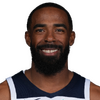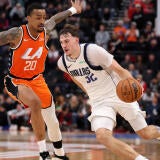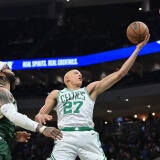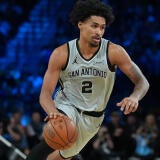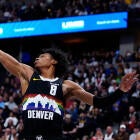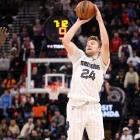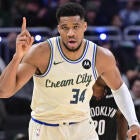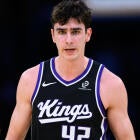Fantasy Basketball: Injury updates on Paul Millsap, D'Angelo Russell and Patrick Beverly
We've got expert analysis on the biggest injuries from around the league.

Jeff Stotts runs InStreetClothes.com, focusing on sports injuries. He will provide short- and long-term updates on various injuries around the league.
The first quarter of the NBA season is drawing to a close with a sudden flurry of injuries set to define the next 20 games. It had been a relatively quiet start to the year for NBA surgeons after Brooklyn's Jeremy Lin and Boston's Gordon Hayward went down in their team's season openers. However, six players have made trips to the operating room since November 16th, including several starting point guards.
The Brooklyn point guard was the first to go down. Russell suffered a left knee injury in a loss to the Jazz that was initially ruled a knee contusion. However, upon further examination the injury was found to be more significant and Russell was forced to undergo a knee debridement. In a debridement, problematic or damaged tissue is surgically removed from an area of the body, often from within a joint. While the Nets have revealed Russell had a "loose body" arthroscopically excised from his knee, the type of tissue removed remains unknown. Loose bodies are often small pieces of bone or cartilage with each type of tissue carrying varying degrees of risk. Debridement procedures are usually performed in the offseason, though several notable players — including Blake Griffin and Kevin Love — have undergone in-season knee debridement in recent years. Both players were able to return before the season's end but missed significant time recovering. The Nets have not put a definitive timeline on Russell's expected recovery but a return before the New Year would likely be a best-case scenario.
It is also worth noting that this isn't the first time Russell has had issues with his left knee. He battled recurring tendinitis in the area last season and eventually underwent a PRP injection to address the problem. An extended absence and an increased level of injury risk make Russell a precarious play for Fantasy owners moving forward. With Lin out as well, Spencer Dinwiddie becomes a must-add in all formats. He has not disappointed with his increase in responsibilities, averaging 15.5 points and 7.5 assists as a starter.
The "Clippers Curse" continues as the team will be without Beverley for the remainder of the season due to injury. Beverley recently underwent surgery to address a lateral meniscus tear. However, Beverley's surgery was more complex than a simple debridement as he also required a specific technique known as microfracture. Microfracture is often performed when damage has occurred to the articular cartilage of a joint.
When performing microfracture, the surgeon first cleans and prepares the cartilage at the injury site and the surrounding area. Next, tiny cracks or "microfractures" are created within the bone using a surgical tool known as an awl. In response to these manufactured cracks, the body's natural defenses are stimulated and a marrow-filled blood clot is created to initiate cartilage repair. Over time, the damage is repaired and replaced with new cartilage. Unfortunately the replacement cartilage is not as strong and durable as the original cartilage, though it is often effective enough to allow the once injured athlete to return to play.
The average recovery time for the surgery depends on the location of the procedure and the size of the area addressed. If microfracture is carried out on a weight-bearing bone like the tibia or fibula the athlete will likely not return to play for at least six to eight months with rehab and recovery often extending longer. Individuals that have microfracture performed on the patella can return as quickly as four months, though a six-month recovery is still considered routine.
Beverley will not return this year but should be ready for the start of the 2018-19 campaign. His absence leaves the Clippers particularly short-handed with Milos Teodosic still sidelined with a plantar fascia injury. Rookie Sindarius Thornwell will start for now but is little more than a stop-gap option. Additionally, both Austin Rivers and Blake Griffin will see an increase in play-making responsibilities.
While not a point guard, Millsap is also expected to miss a prolonged period of time after surgery. Millsap's problem is with his left wrist. The All-Star initially injured the area in a win over the Clippers. The injury was first reported as a sprain though a visit with specialists revealed the damage to be more extensive. Surgery remains the most likely course of action, though Millsap is reportedly considering all his options.
Ligament injuries in the wrist are common in the NBA and there have been cases of players playing through significant tears, including Kobe Bryant, who played the entire 2011-12 season with a torn lunotriquetral ligament in his shooting hand. However the wrist is a complex joint with numerous stabilizing ligaments. The location of the sprain and the associated symptoms often dictate the necessary treatment options. If Millsap does opt for surgery, an extended absence is expected with the forward sitting for up to three months. As a result, Kenneth Faried could be in line for a big boost in value with Juancho Hernangomez and Trey Lyles also options for coach Mike Malone.
Memphis' starting point guard is out indefinitely with lingering soreness in his left Achilles and heel. The Grizzlies have yet to classify the injury as anything more than soreness but that is more of a symptom than a diagnosis. It is likely Conley's injury is similar to that of Kawhi Leonard.
Leonard has missed the start of the season recovering from quadriceps tendinosis, a chronic issue more complex than tendinitis. On Conley's case, the problem is with his Achilles and dates back several seasons. The point guard has battled Achilles tendinitis since the 2015-16 season, when he missed 30 games, including all four of Memphis' postseason contests. He reported lingering soreness last season and multiple flare-ups this year. As a result the team has proactively decided to shut him down to allow the area to heal. While no timeline has been provided, look for this to be a multi-week absence. Mario Chalmers joins the starting unit and is worth a waiver wire claim for the immediate future.
Fast Breaks
- Nicolas Batum, Hornets: Batum suffered another elbow injury, though his latest ailment isn't as severe as his previous sprain. Batum sustained a left elbow contusion that also involved his left ulnar nerve. The term ulnar nerve may not sound familiar but most people have aggravated this site before. The ulnar nerve runs along the superficial surface of the ulna bone. This makes it vulnerable to injury; we just normally refer to it as "hitting your funny bone." Batum may miss a game or two, but his long-term health should be fine.
- Zach LaVine, Bulls: The Bulls guard should be back in mid-to-late December. LaVine has missed the entire season so far as he continues his recovery from a torn ACL. He was recently cleared for full-contact practice and will gradually build up his workload and stamina until he is ready for game action. Fantasy owners looking for a scoring boost may want to consider stashing him if he remains available.
- Delon Wright, Raptors: The reserve guard dislocated his right shoulder on November 15 and is expected to miss a month recovering. The situation is unfortunate but could have been much worse considering this is the same shoulder that required surgery following a similar injury. Fred VanVleet appears to be the biggest beneficiary in terms of Fantasy value.






